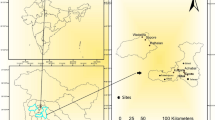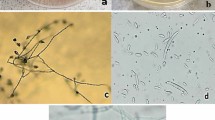Abstract
The incidence of bakanae disease of rice was studied in the basmati growing states of Punjab, Haryana, Uttar Pradesh and Uttarakhand in India. Maximum disease incidence (20 %) was observed from the Karnal district of Haryana and Bulandshar, Ghaziabad and Mathura districts of Uttar Pradesh in rice variety Pusa Basmati 1121 and Pusa Basmati 1509. Disease was also observed in other popular basmati rice varieties of the country including Pusa Basmati 6, Pusa 2511, CSR 30, Pakistani Basmati and Sarbati with the incidence of 0.5 % to 10 %. One hundred and twenty-six isolates of Fusarium spp. were isolated from symptomatic plants and were characterized morphologically and 42 isolates were characterized at the molecular level. Out of 42 isolates characterized based on translation elongation factor 1 α (TEF- 1α), 41 were identified as Fusarium fujikuroi. Virulence analysis performed on rice variety Pusa Basmati 1509 categorized the isolates as moderately virulent (37.3 %), virulent (34.1 %) and highly virulent (28.6 %). Results indicated that F. fujikuroi is predominant in symptomatic diseased plants and a management programme should be developed by considering the prevalence and virulence of the pathogen in the area of intended cultivation.



Similar content being viewed by others
References
Amatulli, M. T., Spadaro, D., Gullino, M. L., & Garibaldi, A. (2010). Molecular identification of Fusarium spp. associated with bakanae disease of rice in Italy and assessment of their pathogenicity. Plant Pathology, 59, 839–844.
Amoah, B. K., Rezanoor, H. N., Nicholson, P., & Macdonald, M. V. (1995). Variation in the Fusarium section Liseola: pathogenicity and genetic studies of Fusarium moniliforme Sheldon from different hosts in Ghana. Plant Pathology, 44, 563–572.
Amoah, B. K., Macdonald, M. V., Rezanoor, N., & Nicholson, P. (1996). The use of the random amplified polymorphic DNA technique to identify mating groups in the Fusarium section Liseola. Plant Pathology, 45, 115–125.
Anonymous (1988). Irtp (p. 54). Manila: IRRI.
Anonymous (2013). Bakanae- a potential threat in basmati rice cultivation in India. IARI Ann. Rep, 85, 2012–2013.
Bashyal, B. M., & Aggarwal, R. (2013). Molecular identification of Fusarium spp. associated with bakanae disease of rice in India. Indian Journal of Agricultural Sciences, 83, 72–77.
Bashyal, B. M., Aggarwal, R., Banerjee, S., Gupta, S., & Sharma, S. (2014). Pathogenicity, ecology and genetic diversity of the Fusarium spp. associated with an emerging bakanae disease of rice (Oryza sativa L.) in India. In R. N. Kharwar, et al. (Eds.), Microbial Diversity and Biotechnology in Food Security (pp. 307–314). India: Springer.
Desjardins, A. E., Plattner, R. D., & Nelson, P. E. (1997). Production of fumonisin B1 and moniliformin by Gibberella fujikuroi from rice from various geographic areas. Applied and Environmental Microbiology, 63, 1838–1842.
Desjardins, A. E., Manandhar, H. K., Plattner, R. D., Manandhar, G. G., Poling, S. M., & Maragos, C. M. (2000). Fusarium species from Nepalese rice and production of mycotoxins and gibberellic acid by selected species. Applied and Environmental Microbiology, 66, 1020–1025.
Geiser, D. M., Jimenz Gasco, M. M., Kang, S., Mkalowska, I., Veeraraghavan, N., Ward, T. J., Zhang, N., Kuldau, G. A., & O’Donnell, K. (2004). FUSARIUM-IDv.1.0: a DNA sequence database for identifying Fusarium. European Journal of Plant Pathology, 110, 473–479.
Hsuan, H. M., Salleh, B., & Zakaria, L. (2011). Molecular identification of Fusarium species in Gibberella fujikuroi species complex from rice, sugarcane and maize from peninsular Malaysia. International Journal of Molecular Sciences, 12, 6722–6732.
Khan, Z. R., Litsinger, J. A., Barrion, A. T., Villanueva, F. F. D., Fernández, N. J., & Taylor, L. D. (1991). World bibliography of rice stems borers 1794–1990 (p. 415). Philippines: IRRI Los Banos.
Kini, K. R., Let, V., & Mathur, S. B. (2002). Genetic variation in Fusarium moniliforme isolated from seeds of different host species from Burkina Faso based on random amplified polymorphic DNA analysis. Journal of Phytopathology, 150, 209–212.
Lenné, J. M., & Ortiz, R. (2002). Agrobiodiversity in pest management. In J. F. Leslie (Ed.), Sorghum and millets diseases (pp. 309–319). Ames: Iowa State Press.
Leslie, J. F., & Summerell, B. A. (2006). The Fusarium laboratory manual. Ames, IA: Blackwell Publishing.
Li, D. J., & Luo, K. (1997). Study of the relationship between the occurrence of bakanae disease in hybrid rice and the application of gibberellins to seed reproduction. Journal of Hunan Agricultural University, 23, 47–49.
Madden, L. V., & Hughes, G. (1999). Sampling for plant disease incidence. Phytopathology, 89, 1088–1103.
Murray, M. G., & Thompson, W. F. (1980). Rapid isolation of high molecular weight plant DNA. Nucleic Acids Research, 8, 4321–4326.
Nelson, P. E., Toussoun, T. A., & Marasas, W. F. O. (1983). Fusarium species: an illustrated manual for identification. University Park, PA, USA: The Pennsylvania State University Press.
O’Donnell, K., Cigelnik, E., & Nirenberg, H. I. (1998). Molecular systematics and phylogeography of the Gibberella fujikuroi species complex. Mycologia, 90, 465–493.
Saremi, H. (2005). Fusarium, Biology, Ecology and Taxonomy. 1st Edn. Jehad Daneshgahi Press University of Mashhad, Iran. pp: 153.
Sarkar, B. B. (1986). Controlling bakanae and foot rot diseases with seed treatments. International Rice Research Newsletter, 11, 18.
Tamura, K., Dudley, J., Nei, M., & Kumar, S. (2007). MEGA 4: molecular evolutionary genetics analysis (MEGA) software version 4.0. Molecular Biology and Evolution, 24, 1596–1599.
Thompson, J. D., Higgins, D. G., & Gibson, T. J. (1994). CLUSTAL W: improving the sensitivity of progressive multiple sequence alignment through sequence weighting, position specific gap penalties and weight matrix choice. Nucleic Acids Research, 22, 4673–4680.
Webster, R. K., & Gunnell, P. S. (1992). Compendium of rice diseases. The American phytopathological society press. Minn: St. Paul.
Wulff, E. D., Sorensen, J. L., Lubeck, M., Nlelson, K. F., Thrane, U., & Torp, J. (2010). Fusarium spp. associated with rice bakanae: ecology, genetic diversity, pathogenicity and toxigenicity. Environmental Microbiology, 12, 649–657.
Yang, C. D., Guo, L. B., Li, X. M., Ji, Z. J., Ma, L. Y., & Qian, Q. (2006). Analysis of QTLs for resistance to rice bakanae disease. Chinese Journal of Rice Sciences, 20, 657–659.
Zainudin N. A. I. M., Razak, A. A., & Salleh, B. (2008). Bakanae disease of rice in Malaysia and Indonesia: etiology of the causal agent based on morphological, physiological and pathogenicity characteristics. Journal of Plant Protection Research, 48, 475–485.
Acknowledgments
The authors are thankful to the Head, Division of Plant Pathology, for providing facilities. Further, the financial support given by the Department of Science and Technology, India, for funding the bakanae project (Code No. SERB/SB/SO/PS/09/2013) is gratefully acknowledged.
Author information
Authors and Affiliations
Corresponding author
Electronic supplementary material
Supplementary Table 1
(DOCX 16 kb)
Rights and permissions
About this article
Cite this article
Bashyal, B.M., Aggarwal, R., Sharma, S. et al. Occurrence, identification and pathogenicity of Fusarium species associated with bakanae disease of basmati rice in India. Eur J Plant Pathol 144, 457–466 (2016). https://doi.org/10.1007/s10658-015-0783-8
Accepted:
Published:
Issue Date:
DOI: https://doi.org/10.1007/s10658-015-0783-8




